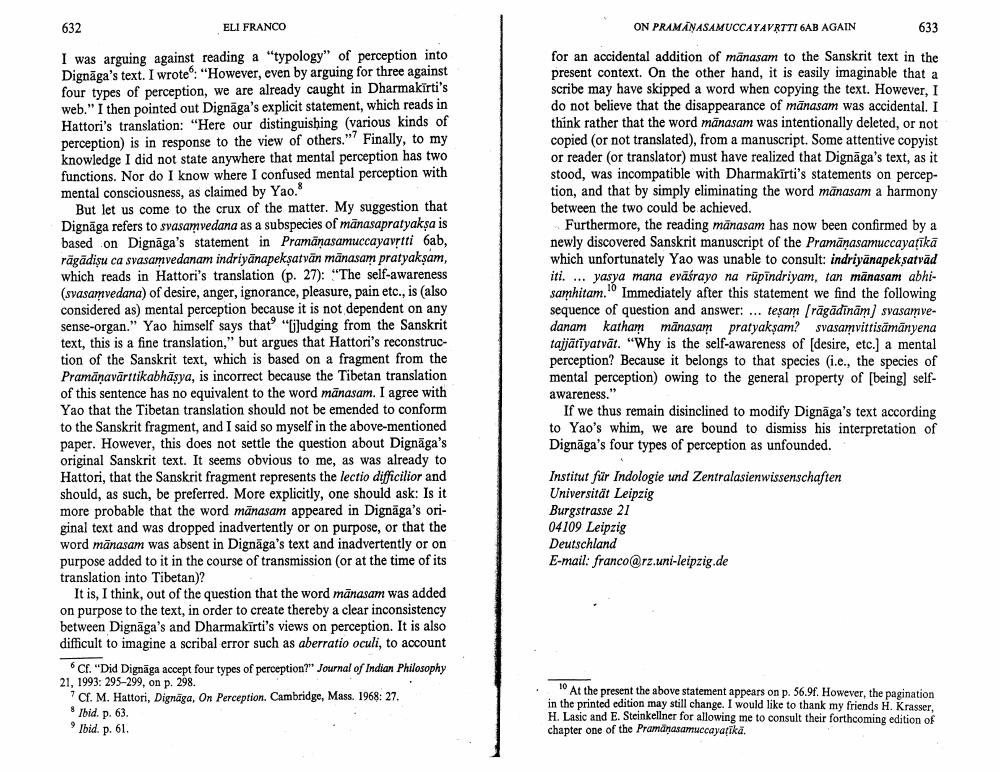________________ 632 ELI FRANCO ON PRAMANASAMUCCAYAVRTTI 6AB AGAIN 633 I was arguing against reading a "typology" of perception into Dignaga's text. I wroteo: "However, even by arguing for three against four types of perception, we are already caught in Dharmakirti's web." I then pointed out Dignaga's explicit statement, which reads in Hattori's translation: "Here our distinguishing (various kinds of perception) is in response to the view of others." Finally, to my knowledge I did not state anywhere that mental perception has two functions. Nor do I know where I confused mental perception with mental consciousness, as claimed by Yao. But let us come to the crux of the matter. My suggestion that Dignaga refers to svasamvedana as a subspecies of manasapratyaksa is based on Dignaga's statement in Pramanasamuccayavrtti 6ab, ragadisu ca svasamvedanam indriyanapeksatvan manasam pratyaksam, which reads in Hattori's translation (p. 27): "The self-awareness (svasamvedana) of desire, anger, ignorance, pleasure, pain etc., is (also considered as) mental perception because it is not dependent on any sense-organ." Yao himself says that "[]udging from the Sanskrit text, this is a fine translation," but argues that Hattori's reconstruction of the Sanskrit text, which is based on a fragment from the Pramanavarttikabhasya, is incorrect because the Tibetan translation of this sentence has no equivalent to the word manasam. I agree with Yao that the Tibetan translation should not be emended to conform to the Sanskrit fragment, and I said so myself in the above-mentioned paper. However, this does not settle the question about Dignaga's original Sanskrit text. It seems obvious to me, as was already to Hattori, that the Sanskrit fragment represents the lectio difficilior and should, as such, be preferred. More explicitly, one should ask: Is it more probable that the word manasam appeared in Dignaga's original text and was dropped inadvertently or on purpose, or that the word manasam was absent in Dignaga's text and inadvertently or on purpose added to it in the course of transmission (or at the time of its translation into Tibetan)? It is, I think, out of the question that the word manasam was added on purpose to the text, in order to create thereby a clear inconsistency between Dignaga's and Dharmakirti's views on perception. It is also difficult to imagine a scribal error such as aberratio oculi, to account Cf. "Did Dignaga accept four types of perception?" Journal of Indian Philosophy 21, 1993: 295-299, on p. 298. ? Cf. M. Hattori, Dignaga, On Perception. Cambridge, Mass. 1968: 27. 8 lbid. p. 63. 9 Ibid. p. 61. for an accidental addition of manasam to the Sanskrit text in the present context. On the other hand, it is easily imaginable that a scribe may have skipped a word when copying the text. However, I do not believe that the disappearance of manasam was accidental. I think rather that the word manasam was intentionally deleted, or not copied (or not translated), from a manuscript. Some attentive copyist or reader (or translator) must have realized that Dignaga's text, as it stood, was incompatible with Dharmakirti's statements on perception, and that by simply eliminating the word manasam a harmony between the two could be achieved. Furthermore, the reading manasam has now been confirmed by a newly discovered Sanskrit manuscript of the Pramanasamuccayatika which unfortunately Yao was unable to consult: indriyanapeksatvad iti. ... yasya mana evasrayo na rupindriyam, tan manasam abhisamhitam.10 Immediately after this statement we find the following sequence of question and answer: ... tesam [ragadinam) svasamvedanam katham manasam pratyaksam? svasamvittisamanyena tajjatiyatvat. "Why is the self-awareness of (desire, etc.) a mental perception? Because it belongs to that species (i.e., the species of mental perception) owing to the general property of [being] selfawareness." If we thus remain disinclined to modify Dignaga's text according to Yao's whim, we are bound to dismiss his interpretation of Dignaga's four types of perception as unfounded. Institut fur Indologie und Zentralasienwissenschaften Universitat Leipzig Burgstrasse 21 04109 Leipzig Deutschland E-mail: franco@rz.uni-leipzig.de 10 At the present the above statement appears on p. 56.9f. However, the pagination in the printed edition may still change. I would like to thank my friends H. Krasser, H. Lasic and E. Steinkellner for allowing me to consult their forthcoming edition of chapter one of the Pramanasamuccayatika.




